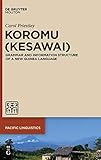Koromu (Kesawai) : Grammar and Information Structure of a New Guinea Language / Carol Priestley.
Material type: TextSeries: Pacific Linguistics [PL] ; 658Publisher: Berlin ; Boston : De Gruyter Mouton, [2019]Copyright date: ©2020Description: 1 online resource (XXVI, 528 p.)Content type:
TextSeries: Pacific Linguistics [PL] ; 658Publisher: Berlin ; Boston : De Gruyter Mouton, [2019]Copyright date: ©2020Description: 1 online resource (XXVI, 528 p.)Content type: - 9781501517099
- 9781501510229
- 9781501510953
- online - DeGruyter
- Issued also in print.
| Item type | Current library | Call number | URL | Status | Notes | Barcode | |
|---|---|---|---|---|---|---|---|
 eBook
eBook
|
Biblioteca "Angelicum" Pont. Univ. S.Tommaso d'Aquino Nuvola online | online - DeGruyter (Browse shelf(Opens below)) | Online access | Not for loan (Accesso limitato) | Accesso per gli utenti autorizzati / Access for authorized users | (dgr)9781501510953 |
Browsing Biblioteca "Angelicum" Pont. Univ. S.Tommaso d'Aquino shelves, Shelving location: Nuvola online Close shelf browser (Hides shelf browser)

|

|

|

|

|

|

|
||
| online - DeGruyter Disputation Literature in the Near East and Beyond / | online - DeGruyter Babylonia under the Sealand and Kassite Dynasties / | online - DeGruyter Good Humor, Bad Taste : A Sociology of the Joke / | online - DeGruyter Koromu (Kesawai) : Grammar and Information Structure of a New Guinea Language / | online - DeGruyter English Pronunciation for Speakers of Spanish : From Theory to Practice / | online - DeGruyter Morphology-Semantics Mismatches and the Nature of Grammatical Features / | online - DeGruyter The Papuan Languages of Timor, Alor and Pantar : Sketch Grammars. Volume 3 / |
Frontmatter -- Preface -- Acknowledgements -- Contents -- List of Tables -- List of Maps -- List of Photos -- Conventions and abbreviations -- Abbreviations for sources (see Appendix 1 for more details) -- 1 Introduction: Linguistic, sociolinguistic, ethnographic and historical contexts -- 2 Phonology and morphophonology -- 3 Basic clause structure -- 4 Word classes -- 5 Noun phrases -- 6 Possessive nominal constructions -- 7 Postpositional phrases -- 8 Spatial reference -- 9 Verb morphology -- 10 Complex verbal predicates -- 11 Impersonal experiencer object constructions -- 12 Basic clause combining -- 13 Noun phrase realization, omission and prominence -- 14 Ground – links and tails -- Appendices -- References -- Author Index -- Language Index -- Subject Index
restricted access online access with authorization star
http://purl.org/coar/access_right/c_16ec
This book is a grammatical description of Koromu (or Kesawai), an endangered and previously undescribed language in Papua New Guinea's Ramu Valley. Koromu belongs to the Madang subgroup of the putative Trans New Guinea family. The grammar covers the structures of the language, with an emphasis on information structure. Geographic, linguistic, social and historical setting are described as well as phonology and morphophonology. The book examines the morphosyntactic structures of the language, covering basic clause structure, word classes, phrase structures and structures of spatial reference, verbal morphology, serial verb constructions, experiencer object constructions and the various constructions of clause combining (clause chaining, complement clauses, adverbial and relative clauses). Chapters also deal with noun phrase (non)realisation and morphological signaling of prominence and show how links and tails are encoded grammatically. Appendices contain texts and a wordlist.
Issued also in print.
Mode of access: Internet via World Wide Web.
In English.
Description based on online resource; title from PDF title page (publisher's Web site, viewed 25. Jun 2024)


